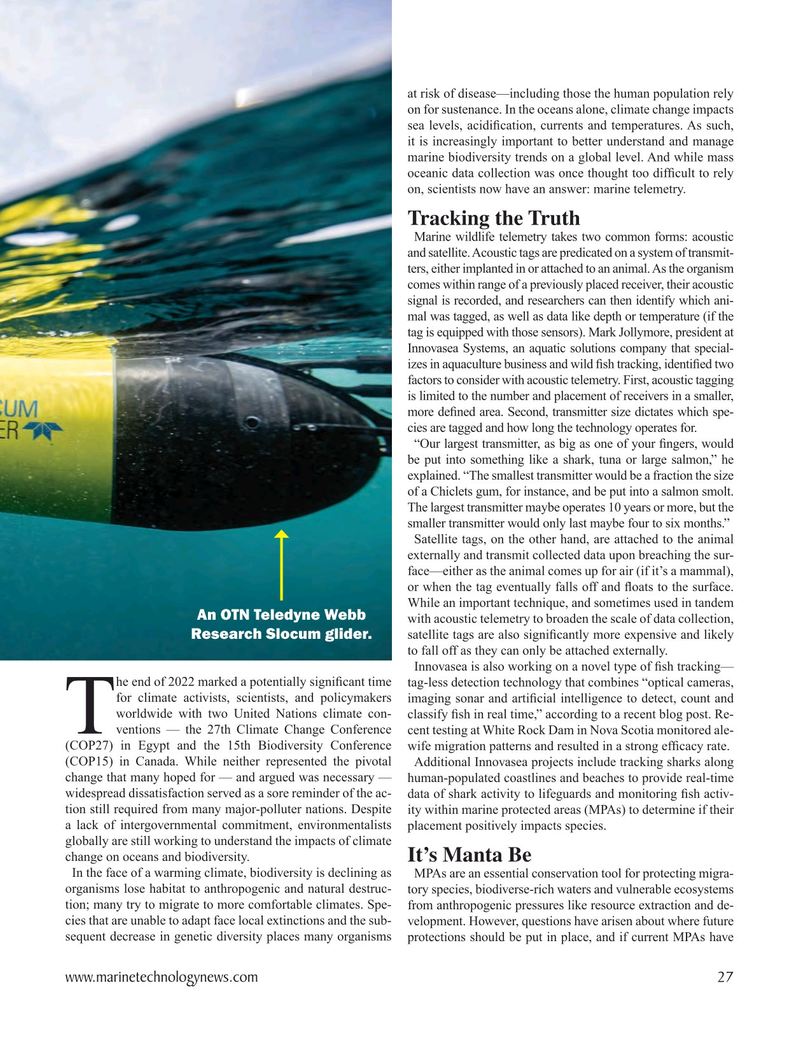
Page 27: of Marine Technology Magazine (May 2023)
Read this page in Pdf, Flash or Html5 edition of May 2023 Marine Technology Magazine
at risk of disease—including those the human population rely on for sustenance. In the oceans alone, climate change impacts sea levels, acidi? cation, currents and temperatures. As such, it is increasingly important to better understand and manage marine biodiversity trends on a global level. And while mass oceanic data collection was once thought too dif? cult to rely on, scientists now have an answer: marine telemetry.
Tracking the Truth
Marine wildlife telemetry takes two common forms: acoustic and satellite. Acoustic tags are predicated on a system of transmit- ters, either implanted in or attached to an animal. As the organism comes within range of a previously placed receiver, their acoustic signal is recorded, and researchers can then identify which ani- mal was tagged, as well as data like depth or temperature (if the tag is equipped with those sensors). Mark Jollymore, president at
Innovasea Systems, an aquatic solutions company that special- izes in aquaculture business and wild ? sh tracking, identi? ed two factors to consider with acoustic telemetry. First, acoustic tagging is limited to the number and placement of receivers in a smaller, more de? ned area. Second, transmitter size dictates which spe- cies are tagged and how long the technology operates for.
“Our largest transmitter, as big as one of your ? ngers, would be put into something like a shark, tuna or large salmon,” he explained. “The smallest transmitter would be a fraction the size of a Chiclets gum, for instance, and be put into a salmon smolt.
The largest transmitter maybe operates 10 years or more, but the smaller transmitter would only last maybe four to six months.”
Satellite tags, on the other hand, are attached to the animal externally and transmit collected data upon breaching the sur- face—either as the animal comes up for air (if it’s a mammal), or when the tag eventually falls off and ? oats to the surface.
While an important technique, and sometimes used in tandem
An OTN Teledyne Webb with acoustic telemetry to broaden the scale of data collection, satellite tags are also signi? cantly more expensive and likely
Research Slocum glider. to fall off as they can only be attached externally.
Innovasea is also working on a novel type of ? sh tracking— he end of 2022 marked a potentially signi? cant time tag-less detection technology that combines “optical cameras, for climate activists, scientists, and policymakers imaging sonar and arti? cial intelligence to detect, count and worldwide with two United Nations climate con- classify ? sh in real time,” according to a recent blog post. Re-
Tventions — the 27th Climate Change Conference cent testing at White Rock Dam in Nova Scotia monitored ale- (COP27) in Egypt and the 15th Biodiversity Conference wife migration patterns and resulted in a strong ef? cacy rate. (COP15) in Canada. While neither represented the pivotal Additional Innovasea projects include tracking sharks along change that many hoped for — and argued was necessary — human-populated coastlines and beaches to provide real-time widespread dissatisfaction served as a sore reminder of the ac- data of shark activity to lifeguards and monitoring ? sh activ- tion still required from many major-polluter nations. Despite ity within marine protected areas (MPAs) to determine if their a lack of intergovernmental commitment, environmentalists placement positively impacts species. globally are still working to understand the impacts of climate change on oceans and biodiversity.
It’s Manta Be
In the face of a warming climate, biodiversity is declining as MPAs are an essential conservation tool for protecting migra- organisms lose habitat to anthropogenic and natural destruc- tory species, biodiverse-rich waters and vulnerable ecosystems tion; many try to migrate to more comfortable climates. Spe- from anthropogenic pressures like resource extraction and de- cies that are unable to adapt face local extinctions and the sub- velopment. However, questions have arisen about where future sequent decrease in genetic diversity places many organisms protections should be put in place, and if current MPAs have www.marinetechnologynews.com 27
MTR #4 (18-33).indd 27 5/31/2023 3:59:58 PM

 26
26

 28
28
